Dental Braces Care
The development process & maintaining good oral health
|
This page offers indepth information on dental braces care, some of the reasons why braces are needed and the process that goes into making these orthodontic appliances. As a bonus, I have included a short video showing the process of how orthodontic braces are made. |
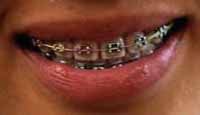 |
Dental Braces CareOrthodontic braces is the process in which teeth are slowly moved and shifted into proper position by pressure being applied in certain directions. Bands, wires and elastics are placed on the teeth to move them in the desired direction. This process of shifting teeth into a functional position can take months to years, but eventually you'll have a new and improved mouth using good dental braces care techniques. |
If you currently wear braces, it is important to follow care guidelines to maintain healthy teeth and gums as your teeth are going thru the straightening process. Not following dental braces care can damage your dental braces. For instance, it is important to wear a mouth guard when playing physical sports. Also, avoiding certain sticky or hard foods, such as popcorn, nuts, raw carrots, large hard pretzels, gum, and caramel will promote good dental braces care. Limiting starch and sugar intake also shows good dental braces care, as these types of foods turn into damaging acids which promote plaque formation.
Brushing and flossing thoroughly when wearing braces can prevent tooth decay, decalcification, or color changes to the teeth. Food, in general, has a tendency to become easily lodged into braces. Brushing carefully after every meal with fluoride toothpaste and a soft-bristled toothbrush helps to achieve good dental braces care. Flossing daily between the teeth and the braces, and getting a professional cleaning performed every six months are also ways to maintain good dental braces care.
DENTAL BRACES CARE TABLE OF CONTENTS
- Orthodontics and Orthodontists
- The Process of Getting Braces
- Post-Treatment
- Pre-Finishers
- Complications and Risks
- Developing Good Habits
- Dentist Emergency
- Treatment Time and Cost
- Types of Braces
- Invisalign - an Alternative to Traditional Braces
- Dental Braces Summary
Orthodontic metal brackets (braces). The brackets include one slot, where the orthodontic wire is usually inserted. The brackets shown in this image are called twin brackets, since they have two couples of wings where a metal or elastic ligature can be added. |
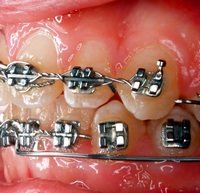 Dental Braces Care - Fig 1 |
Dental Braces Care - Orthodontics and Orthodontist
Orthodontics is the dental specialty that focuses on the development, prevention, and correction of irregularities of the teeth, bite, and jaws. An orthodontic problem may be classified as a malocclusion, or "bad bite." But, orthodontics is not always for aesthetic purposes. Braces may be prescribed in cases of so-called "overbite" to help prevent teeth being accidentally knocked out in such sports as hockey or football.
Orthodontists use dental braces, (aka orthodontic braces or brackets), to correct the alignment and position of teeth, crooked teeth, and various other flaws of the teeth. Orthodontic braces may also be used in conjunction with other orthodontic appliances to correct the jaw position and disorders of the jaw joint. The orthodontist will align the teeth with respect to the surrounding soft tissues, with or without movement of the underlying bones, which can be moved either through growth modification in children or jaw surgery in adults.
Several appliances are utilized for growth modification; including functional appliances, headgear, and face masks. These "orthopedic appliances" may influence the development of an adolescent's profile and give an improved aesthetic and functional result.
Orthodontic Treatment of Crowded Teeth
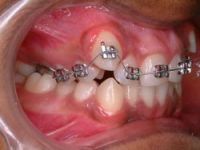 |
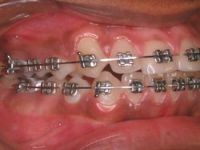 |
| Dental Braces Care - Fig. 2 The canine is being pulled down into proper position with highly flexible co-axial wire. |
Dental Braces Care - Fig. 3 Results after 10 months of Treatment. Further treatment is necessary to correct the bite. |
The Process of Getting Braces
Dental Braces Care - The Initial Consultation
The process of getting braces involves an orthodontic evaluation to determine if braces are suitable for you.
Note: Moving and correcting the alignment of the teeth follows the same biological and physical process no matter what the age. However, because an adult mouth must overcome already positioned facial bones and jaw structure, adults may require an additional type or types of orthodontic treatment. In most cases, the ideal age for braces and other orthodontic treatments, is between 10 and 14 years of age. But, people of any age can benefit from orthodontic treatment.
A consultation is held with the orthodontist as he visually inspects the teeth of the patient. If braces are suitable for the patient, a records appointment is setup. A record appointment involves making X-rays, molds, and impressions of the patient. These records are analyzed to determine the problems and to develop a proper course of action. Typical treatment times vary from six months to six years. This is dependent upon the complexity of the case. In extreme cases, surgery may be required in the course of treatment.
Note: Patients with periodontal disease usually must obtain periodontal treatment before getting braces. A deep cleaning is performed, and further treatment may be required before beginning orthodontic treatment. Bone loss due to periodontal disease may lead to tooth loss during treatment.
Dental Braces Care - Moving Forward
If all is well, then begins the process for dental braces. An etchant is applied to each tooth that will need to be braced. Etching the tooth helps the cement to bond to the surface of the tooth. A bracket is then applied to the cement, and then cured with light until hardened.
The process usually takes a few seconds for each tooth. If necessary, orthodontic spacers are inserted between the molars to make room for molar bands. Molar bands are placed at a later date. These bands are required to ensure that the brackets will hold. Molar bands are also used when dental fillings or other dental work prevent a bracket from being secured to a tooth.
After the teeth are secured with the bracket, archwire is threaded between the brackets and binded with elastic or metal ligatures. Nickel-titanium archwires and temperature-sensitive materials are the most frequently used by orthodontists. This is because when nickel-titanium archwire is cold, it is limp and flexible. This allows for it to be easily threaded between brackets. Once it is heated to body temperature, the archwire stiffens and seek to stiffen and retain its shape, creating a constant force on the teeth.
Elastics are then used to close open bites, shift the midline, or create a stronger force to pull teeth or jaws in the desired direction. If necessary, brackets with hooks can be created, placed, and affixed to the archwire, which is then affixed to the elastic. Because the placement and configuration of the elastics varies from patient to patient, elastics are made in different diameters, sizes, and strengths.
In many cases, due to insufficient space in the mouth for all the teeth to fit properly, two procedures may be used. One is extracting the teeth to create more space - the other is expansion. Expansion involves enlarging either the palate or arch using an expander. The expansion procedure is used with both children and adults. But, because the bones of adults are joined, or fused to the arch, surgery is often necessary to expand the palate. Surgery is not required to expand the arch for an adult patient.
Below is a video of showing the process of braces being placed on a dental patient by an orthodontist. This 5 minute video is provided courtesy of YouTube.
Dental Braces Care Post-Treatment
|
After the braces have been removed, a retainer is used to keep the teeth in their new position. Some patients may need orthodontic surgery, such as a fiberotomy, to prepare their teeth for retainer use. A fiberotomy is designed to remove the gingival fibers around a tooth. This procedure usually reduces the tendency for relapse of the tooth. |
 Dental Braces Care - Fig 4 Hawley retainers - Top and Bottom |
Retainers are usually worn by patients once treatment with the braces is complete. Retainers maintain the teeth while the surrounding bone reforms around them. Retainers are generally worn full-time for a short period, perhaps 6 months to a year, and then worn periodically, typically nightly during sleep, for as long as the orthodontist recommends. If a patient does not wear the retainer as recommended, the teeth might move back to their original position.
While it is possible for the teeth to stay aligned without regular retainer wear, there are many reasons teeth will crowd as a person ages. For this reason, many orthodontists recommend periodic retainer wear for many years, or indefinitely, after orthodontic treatment. The three most popular retainers used in dental braces care are the Hawley retainer, the Essix retainer and a Fixed retainer.
Hawley Retainer - a Hawley retainer is made of metal hooks that surround the teeth and keeps them in place. It is anchored in a specially molded, sometimes brightly colored acrylic plate shaped to fit the patient's palate, or floor of the mouth. Top and bottom retainers are usually made as necessary.
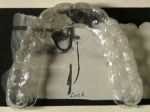 Dental Braces Care - Fig 5 Essix Retainer |
Essix Retainer - an Essix retainer is similar in appearance to Invisalign trays. It is a clear plastic tray form-fitted over the entire arch of teeth and can be produced from a mold and stays in place by suction. Essix retainers, if worn 24 hours per day, do not allow the upper and lower teeth to touch because plastic covers the chewing surfaces of the teeth. Some orthodontists feel that it is important for the top and bottom chewing surfaces to meet to allow a "favorable settling" to occur. Essix retainers are less expensive, more aesthetic and easier to wear than Hawley retainers. |
Most removable retainers come with a retainer case to protect them. During the first few days of retainer use, many people will have extra saliva in their mouth. This is natural and is due to the presence of a new object inside the mouth and consequent stimulation of the saliva glands. It may be difficult to speak for a while after getting a retainer, but this speech difficulty should go away over time as one gets used to wearing it.
An entirely different category of orthodontic retainers, by definition not removable, are bonded or Fixed Retainers which consist of a wire permanently bonded to the tongue-side of the lower incisor teeth, although other teeth are occasionally treated in similar fashion. Some doctors prescribe fixed retainers regularly, especially when a significant change has occurred in the bite and there is a high risk for reversal.
Dental Braces Care - Pre-Finishers
If a person's teeth are not ready for a proper retainer, the orthodontist may prescribe the use of a pre-finisher. A pre-finisher is a rubber appliance that is similar to a mouthguard. It fixes minor problems that a dental brace cannot such as gaps between the teeth and small spaces between the upper and lower jaw.
The pre-finisher is molded to the patient's teeth using strong pressure by the patient's jaw. It is worn for a prescribed period of time. The patient will apply force with the pre-finisher in their mouth for ten to fifteen seconds at a time. The goal is to steadily increase the time the patient spends applying force to the pre-finisher. Similar to a retainer, the pre-finisher can be moved freely in and out of the mouth.
Dental Braces Care - Complications and Risks
Allergic ReactionsThere is a small chance of allergic reaction to the latex rubber in elastics or the metal used in braces. Latex-free elastics and alternative metals can be used instead. If a person with braces believes that they are allergic to their braces, it is important to notify the orthodontist immediately.
Mouth Sores
Mouth sores may develop because of irritation from components of the braces. Some products that can be used to increase comfort include oral rinses, dental wax or dental silicone, and other products designed to help heal sores.
White Spot Lesions
Because the way braces are designed, it is very difficult to effectively brush and floss the teeth in order to remove plaque. Yet, it is extremely important for someone who wears braces to understand that during the period when braces are in place, there is an increased risk for tooth decay formation and a condition known as white spot lesion to develop.
White spot lesion is the result of the acids, produced by the oral bacteria found in dental plaque, dissolving away the mineral content of the tooth's enamel. The demineralization process changes the quantity and quality of the tooth's mineral, thereby changing the appearance of tooth enamel to an opaque whitish color.
If dental plaque accumulates around a person's braces, white spot lesions will form on the tooth's enamel area around the orthodontic brackets. The enamel that is underneath the orthodontic bracket has been protected from plaque formation. So when orthodontic treatment has been completed, and the braces have been removed, a white spot lesion outlining the original position of the orthodontic bracket is apparent, effecting the cosmetic appearance of the tooth, resulting in additional dental braces care work.
Dental Braces Care - Developing Good Habits
Sports and Other Physical Activities
Participating in physical sports and eating certain foods will damage your dental braces and prolong your orthodontic treatment. As a reminder, wear a mouth guard when playing physical sports such as hockey, football and tumbling exercises. Avoid sticky and hard foods, and limit your starch and sugar intake when wearing dental braces. Care and awareness of what you do and eat will result in good dental braces care.
| Dangerous Foods Candy and foods that are sticky and chewy, or hard and crunchy, create the biggest dental braces care problems for kids and adults wearing braces or retainers. Hard foods should be avoided since they can bend the wires, loosen the bands, or break the brackets. Sticky foods such as gum, toffee and caramel should be avoided since they can bend and break the wires and brackets. Foods high in sugar should also be avoided, since sugar increases the chances of tooth decay. These things can damage your braces and lengthen treatment time. |
Oral Hygiene Care for Braces
Brushing and flossing daily and having a professional cleaning performed every six months will promote optimal dental braces care.
-
Dental Braces Care - Adopt a Plaque Control Program
- Turn the toothbrush at a 45° angle to the gum. Apply gentle pressure as you brush with a short back-and-forth motion, cleaning each tooth individually for about 10 seconds.
- Brush over the front and back and chewing areas of each tooth.
- Brush the lower teeth up and the upper teeth down.
- Brush your tongue and the roof of your mouth.
- Remember to brush the chewing surfaces of your teeth - including the back teeth.
- See the video entitled "Brushing with Braces"
- Choose a waxed floss and curve the floss around each tooth in a "C" shape.
- With dental floss wrapped around the tooth, gently move it up and down the side of each tooth, including under the gum line.
- Unroll a new section of dental floss as you move from tooth to tooth.
- Carefully pull waxed floss between wire and braces.
- See the video entitled "How to Floss Your Teeth"
Braces collect food and dental plaque very easily. If proper oral hygiene is neglected during orthodontic treatment both tooth decay and periodontal disease can easily occur. Maintain a dental braces care program which incorporates daily plaque control program. You can start by at least carrying a travel toothbrush with you so you can brush after meals or anytime you have had something to eat. An interdental brush can be used to fit between the wire and the tooth to remove hard-to-reach plaque and food debris. Waterpik or Panasonic oral irrigators, should also be considered for using as adjuncts to brushing and flossing. Most oral irrigators are small but powerful. They are designed to clean debris between teeth and massages gumlines for healthy gums and are great tools for cleaning braces. Most irrigators have a large water tank capacity which allows for longer periods of use at home or while traveling.
Following are techniques to use when brushing and flossing your teeth which promote good dental braces care.
Brushing Techniques
At least twice a day, brush very thoroughly for at least three minutes. A soft toothbrush should be used. A special orthodontic toothbrush can also be used to brush your teeth. Use a small amount of fluoride toothpaste. Avoid using a tooth whitening product toothpaste. You should brush in the morning, before bed and after every meal using the following technique:
Cleaning Braces
It is very important to also clean your braces every time you brush your teeth. Braces can trap plaque which increases your risk of cavities and gum disease. After brushing your teeth, finish the process by cleaning around your braces.
Brush gently, first from the top and then from the bottom the dental braces. Care should be given not to break or bend any of the brackets or wires.
Don't forget to brush your gums as well as your teeth. After brushing, be sure and look at your teeth very thoroughly in the mirror to make sure you have gotten rid of all the plaque on your teeth.
If you are unable to brush after a meal, be sure to do a good mouthwash rinse with water.
Flossing with Dental Braces
Flossing with braces takes more time than usual. Superfloss or floss threaders can aid in flossing, and make it more time efficient. Floss nightly after brushing to remove the plaque missed by brushing during the day. Flossing removes the plaque between your teeth and under your gum line. If you do not floss, you are leaving up to 40% of your tooth surfaces untouched and prone to decay. Use the following technique to floss with dental braces:
Mouth Rinse for Dental Braces
A mouthwash or mouth rinse containing fluoride should also be used to help prevent cavities from occurring. Use a fluoride mouth rinse at least once daily to help reduce the risk of cavities.
Cleaning Dental Retainers
Retainers are often used to hold the teeth in their new position until they are stable. If prescribed by your dentist, it is important to wear the appliance for however long it takes. If you quit at any point during treatment, the teeth can shift back into their old position. Dental retainers may be cleaned using your toothbrush and toothpaste, and rinse it thoroughly with water.
Dental Braces Care - Dentist Emergency
You may experience pain once the braces are initially installed and find eating to be difficult. This is not uncommon for newly installed dental braces. Care should be given for the first several days - try to eat soft foods to avoid placing additional pressure on your teeth.
In the course of treatment, orthodontic brackets may pop off due to the forces involved or to the cement weakening over time. Please refer to the article on dental emergencies which explains how to administer good dental braces care prior to contacting your orthodontist for immediate care. In many cases, the bracket will be replaced.
Dental Braces Care - Treatment Time and Cost
Typical treatment time for orthodontic braces is from six months to six years, depending on the individual patient. Two years is usually the average. The average cost of braces is about $5,000 in the US, but can be much lower in other countries. It is very important to develop good dental braces care techniques.
Dental Braces Care - Types of Braces
There are many types and varieties of dental braces:
Traditional braces are stainless steel, sometimes in combination with nickel titanium, and are the most widely used. They offer many types of brackets, including conventional ones requiring ties and newer self-tying (or self-ligating) brackets, like SPEED and Damon brackets. These types of braces are often referred to as 'train-tracks'.
Gold-plated stainless steel braces are for people allergic to nickel, but may also be chosen because they blend in better with the teeth. Cosmetically, some people prefer the look of gold over the silver-colored braces.
Ceramic braces offer a less visible alternative. They blend in more with the natural color of the tooth and are more visually appealing. Some ceramic brackets are not as strong as the metal brackets and may require a longer treatment period. Some ceramic brackets are also slightly larger than the metal ones and patients may find it more difficult to adapt to using.
Lingual braces are fitted behind the teeth and are not visible. They can also be more difficult to adjust to because they can hinder tongue movement.
Dental Braces Care - Alternative to Traditional Braces
For some patients, Invisalign might be a viable alternative to braces. The Invisalign system is a method of orthodontic therapy promoted as an "invisible" way of straightening teeth without using traditional braces. It instead uses a series of clear custom-fabricated aligners designed to gradually and sequentially move teeth to their desired positions. This system is not recommended for more difficult cases, or for people whose last molars have yet to erupt.
The main advantage of using Invisalign is cosmetic: the aligners are completely transparent and difficult to detect. This makes the method particularly popular among adults who want to straighten their teeth without the unflattering look of traditional metal braces, which are commonly worn by children and adolescents. In addition, the aligners are marketed as being more comfortable than braces. According to the company, Invisalign aligners are more comfortable than metal braces as they may not irritate the soft tissue of the mouth as much as traditional braces. Due to the removable nature of the device, various food types can be enjoyed without the encumberance of metallic braces.
Despite the considerable cosmetic advantage of Invisalign, the product also has some disadvantages: the very fact that the aligners are removable means they are not continually correcting the teeth. Like traditional fixed braces, they are largely dependent on a patient's habits and their consistency in wearing the aligners.
The aligners must be removed for eating and, afterwards, they and the teeth should be cleaned before re-inserting. This can be troublesome for people who are constantly snacking and may mean the patient has to clean their teeth up to six times daily. However, this tends to discourage snacking, which some people might find useful.
Unlike traditional braces, a patient may damage the appliance is grinding or clenching of their teeth during the day or while sleeping is constant. A new aligner may be required or it may be suggested that a patient switch to a metal retainer. Also, aligners or braces may cause a slight lisp at the beginning of treatment. This lisp usually disappears as the patient becomes used to the treatment.
The treatment price of Invisalign is often the same as or less than traditional braces. Treatment price is set by the dentist or orthodontist, and could vary considerably. Doctor fees are usually determined by complexity and length of treatment. Many treatments run $3500 - $9000, with some treatments priced as low as $2000.
The Invisalign Process |
|
Seeking Invisalign Treatment?
Although most orthodontists and many dentists are certified to provide Invisalign treatment, it is important to find an experienced doctor.
Invisalign's web site lists the most experienced Invisalign providers in the U.S. and Canada. But it is also beneficial to seek a second option to determine applicability and pricing differences.
The Invisalign system may be most suitable for skeletal and dental Class I, mildly crowded orthodontic cases with good profile (less than 3 mm of crowding), that normally can be treated with removable retainers. Rotations of the posterior teeth tend to be difficult to resolve. Compliance with these appliances is necessary, and the patient is expected to wear them for at least 20 hours per day. Unlike traditional dental appliances, most patients are actually motivated to wear these appliances because of their superior aesthetics.
There is an advantage for patients using these appliances if they have periodontal or gum problems because, unlike appliances like braces, these removable appliances allow easy daily oral hygiene practices.
If you have a particularly difficult case, it is advisable to seek a proper consultation and diagnosis from an orthodontist prior to starting treatment. Generally, orthodontists can perform more complex movements than dentists and can supplement these clear retainers with a brief period of fixed appliances (traditional braces) to either attain complex tooth movements prior to starting or detailing the dentition at the conclusion of treatment. Be certain to practice good dental care habits during this period.
Dental Braces Care Summary
Regular dental appointments are important to monitor the health of the teeth and gums during any orthodontic treatment. Orthodontics involves a lot of work and commitment, but in the long run, the results are worthwhile for a new and improved smile. Developing good dental braces care techniques will assist you with this investment.
Most of this information on dental braces care was researched using Wikipedia® - the free encyclopedia created and edited by online user community. Although the vast majority of the Wikipedia® encyclopedia articles provide accurate and timely information please do not assume the accuracy of any particular article. This information on dental braces care is provided to you under the terms of GNU Free Documentation License.
